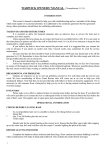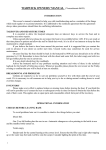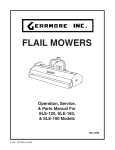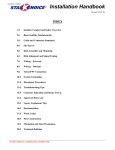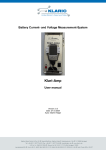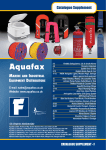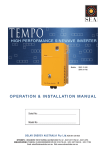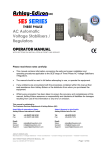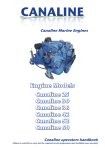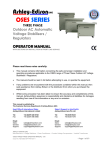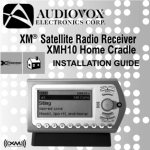Download WARWICK OWNERS' MANUAL (*Amendments 03/14)
Transcript
WARWICK OWNERS’ MANUAL (*Amendments 03/14) This owner’s manual is intended to help you with troubleshooting and as a reminder of the things which need regular or occasional attention. It is additional to the syndicate agreement but the agreement always takes precedence should there be conflicting information. TAKEOVER AND DEPARTURE TIMES It is essential to allow the boatyard adequate time on takeover days to service the boat and to complete any minor repairs. Unless agreed otherwise please do not expect the boat to be available before 1430. If it is not ready at that time please be patient and allow the staff to finish their work. It is in all of our interests to keep the boat maintained to a high standard. If you believe the boat to have been unused the previous week it is suggested that you contact the yard in advance if you desire an earlier start time. Unused weeks may sometimes be used for maintenance. On your final day the boat should be back in the boatyard by 0930 and you should aim to be off the premises by 1130. Remember to leave the boat with the diesel and water full, the toilet empty and with two full gas bottles plus the one in current use. If in any doubt check/clear the weedhatch. Advise the boatyard staff of any problems needing attention preferably face to face but if necessary by means of the handover sheet and write of these in the technical logbook. Whenever possible please phone the next owner on the Friday evening to confirm that you will be back at base on schedule. BREAKDOWNS AND PROBLEMS Callouts are expensive so try to sort out problems yourself or live with them until the end of your week. We have membership of River Canal Rescue who will come out at no cost to help you with mechanical failures. Note that they do not provide help with failure of items of domestic equipment. If it is necessary to call someone from a boatyard to help you try to do so during normal working hours to avoid overtime charges. RCR cover now includes limited parts and labour costs. A membership booklet and phone numbers are carried on board. INVENTORY Please make every effort to replace broken or missing items before leaving the boat. If you think this will not be possible try to contact the next or subsequent owner in time for them to obtain the item before the start of their week. This applies also to spare parts and consumables which form part of the inventory. OPERATIONAL INFORMATION CHECKS BEFORE LEAVING BASE To avoid problems later on it is sensible to check a few things before you start. Diesel full. Gas. Two full bottles plus the one in use. Toilet empty Header tank for the central heating at the correct level. Top up if necessary with premixed antifreeze. Ensure that the filler cap is tight after topping up or the water may boil and overflow onto the carpet. Consider lighting the pilot at this time. BEFORE LEAVING FOR HOME Complete the handover sheet, technical and diesel logs. Draw curtains and ensure bedding is not left where condensation will make it damp and mildewed. This includes the under dinette stowages. 1 DAILY CHECKS Stern tube greaser. Tighten morning and evening. If necessary refill with grease. Alternator drive belt. Not frayed or too slack. There should be 10 to 20 mm of play. Engine oil level. Important: To obtain an accurate level this check must be carried out when the engine is cold. Remove and wipe the dipstick before putting it back then remove it again to see the level. Note that the dipstick may read low when first removed so it is important to replace the dipstick and take a second reading. It is important to not overfill. Spare oil is carried on board although replenishment is not normally required. Top up if necessary through the filler cap marked OIL. Report the need to top up to the chairman. * Engine coolant level. Important: This must also be checked when the engine is cold. The expansion tank is in the left rear corner of the engine room. The level should be between the max and min markings. A torch may be useful. Diluted antifreeze (40%) is carried for topping up, stowed below the engine room floor. If necessary top up through the cap on top of the header tank being careful not to overfill. Warwick now uses RED antifreeze in both engine and central heating. Important: Never top up with blue antifreeze as the two kinds are not compatible. Check that the overflow container under the rear step is empty. If there is coolant in it this probably means air is trapped in the cooling system and this must be vented as described in the ENGINE section. If a significant amount of air is vented it is reccommended to vent the system again next day. Report any problems or need for topping up to the chairman. Bilge water. Run the pump until the flow of water splutters. OCCASIONAL CHECKS Weed Hatch. If your speed drops for no apparent reason or you notice vibrations this may be due to debris around the propeller. Sometimes a short burst in reverse will clear it but, if not, the prop will have to be cleared manually. Using the light below the rear step will be helpful. Important: Before removing the weedhatch take out the ignition key and put it in your pocket. This will ensure that the engine cannot be started accidentally whilst the hatch is open which could cause sinking of the boat and/or serious injury to yourself. Remove the section of bulkhead in the right rear corner of the engine room. Crawl through the gap and unscrew the locking bar until you can lift it out. Lift off the sealing plate. Now you have direct access to the prop. Remove all the foreign objects for later disposal. You may need a knife or even wire cutters. If so tie a piece of string to them in case you drop them. Take particular care if you encounter fishing line as there may be a hook attached. If the water is particularly cold boil a kettle and pour the contents through the hole which will keep the water round the prop warmish for several minutes. When all is clear replace the sealing plate and locking bar. Start the engine, engage a gear and make a visual check that you have achieved a water tight seal. Leaks through the weedhatch are by far the most common cause of sinking of narrowboats. Batteries. If the batteries are not the sealed type remove the cell caps and check that the electrolyte just covers the top of the plates. Top up with distilled water. Gearbox oil level. The dipstick is integral with the filler cap. This is a large nut on the top of the box. A spanner is required. A low level probably indicates a leak which should be reported to the boatyard and the chairman. Low oil level may result in loss of drive. The gearbox uses the same oil as the engine. Cabin bilge. Remove the step in the main cabin and the contents of the stowage. A small section of the floor can be lifted out to enable the level of water to be seen. There should be little or none. If necessary ask the boatyard to pump it out at the end of your week. 2 SAFETY EQUIPMENT Fire extinguishers are located in engine room, rear and main cabins and galley which also has a fire blanket. Two smoke detectors are fitted. The one in the galley should be immune to false alarms caused by cooking. * Two carbon monoxide detectors are fitted. They will sound an alarm if dangerous levels of CO are detected. Their batteries are sealed for life and not replacable. They have digital readouts in parts per million. Up to 35ppm is safe for up to 8 hours. Refer to instruction booklet. Gas leakage alarms and switches are fitted in the wardrobe and below the cooker. Switch them off at the end of your week to avoid a drain on the batteries. The door between main cabin and engine room is divided to allow egress when the bed is in use. A battery isolation switch is under the engine room floor in the left rear corner. * An emergency engine stop cable is by the side of the engine. Pull and hold until the engine stops. The lifebelt should be kept within reach of the steerer whilst underway. A first aid kit is kept in the front wardrobe, please replace any items used. Three adult lifejackets and two for children are provided. USE OF THE ANCHOR The anchor is stowed in the foredeck. It is for emergency use only, e.g. in case of engine failure above a river weir. It should never be required on the canals. Its rope is kept in a box on the foredeck. The rope and chain should be wound in the storage box in such a way that it will come out without tangling. Important: Before going onto a river connect the chain to the anchor and the rope to the boat. Make sure that all crew members understand its purpose and know how to deploy it. Warning: If you need to deploy the anchor the boat may stop suddenly or heel over as the rope becomes tight so remind crew to hold tightly to the boat. To reduce snatch and because the chain attachment is untested it is recommended to drop the loop which is tied in the rope over the T stud on the foredeck. If possible deploy the anchor in a controlled manner rather than just throwing it over the side. Note: The anchor may be kept at the home of an owner whilst the boat’s mooring is remote from any rivers. If you think it may be needed on a forthcoming trip please contact the chairman in advance. KEYS AND LOCKS Each owner is supplied with an ignition key, a safe key and a key to the padlock for the rear doors. A key for the front door is kept in the top of the front wardrobe along with a Calor gas spanner, BW keys, water/pumpout key and assorted hosepipe fittings. The fuel filler key is kept in the engine room. A chain and combination 5393 lock can be used to secure the buckby can on the roof. When leaving the boat it is recommended to lock and bolt the front doors from inside and make your final exit from the rear. Narrowboats are not very secure against determined thieves so choose your mooring places with care and do not leave valuables in view from the towpath. At night you may wish to use the bolts under the rear hatch. Deck equipment should be moved inside when the boat is left unattended. BACK DECK AND ROOF The fuel filler is on the back deck and the tank is underneath. It holds around 225 litres (50 gallons) of diesel, sufficient for two to three weeks cruising. The key for the lock is kept in the engine room near the extinguisher. After refuelling enter the details in the fuel log and add ‘Fuel Set’ additive in the quantity indicated by the chart. Normally, fuel use should be declared as 60/40 for taxation purposes. A stop tap in the feed pipe to the engine is located near the weedhatch. On the roof are two planks, two poles, a boathook and a false chimney. Also the real chimney for the stove, the centre rope, brass mushrooms, pigeon box, barrel, buckby can and lifebelt. The lifebelt should be kept at the rear of the boat within reach of the steerer. It is strongly recommended that when moored the loose items of inventory be taken inside the boat. Any items lost during your week are your responsibility. Please replace them before you leave if at all possible. 3 FRONT COCKPIT AREA * The front locker contains 3 gas bottles, a manual changeover valve, and a hosepipe (approx 18m) on a reel. An additional length (approx 12m) is also carried.Assorted hose fittings and a gas bottle spanner are in the front wardrobe. Note: Calor gas bottles use a left hand thread. The gas bottles should be secured in place with the chain and clip attached inside the locker. Below the floor of the cockpit is the water tank which holds about 100 gals. Its filler is on the left gunwale and an overflow pipe exits on the right of the boat. A level gauge is located behind the TV, the adjacent light must be turned on to provide it with power. Readings below a quarter may be unreliable. The cratch is in three pieces. The 2 triangular sections can be removed to improve forward visibility and can be stowed on the front side of the centre section but need to be removed from there to access the gas locker. An alternative set of triangles with windows are available. It may be convenient to leave one pair in your car boot whilst you are cruising. The cratch cover can be rolled up and secured with straps in several different cofigurations if not required for use. Please roll it down and secure it in place at the end of your week. When cruising with it rolled down take care not to scrape it on bridges or tunnel walls. ENGINE ROOM Inside the rear doors on the left is the combined gearlever/ throttle control. With the lever in the centre pushing in the small orange tab disengages the gear selector. Rocker switches work the horn, headlight and bilge pump. Under the forward edge of the hatch slide is another pushbutton switch which sounds a bell in the galley. To protect the paintwork please use the loop provided to secure the door hook when it is not in use. In the left rear corner is the expansion tank for the engine cooling system with max and min level marks (engine cold). The filler cap is on top. Premixed water antifreeze is carried for topping up. Below this is the stern gland greaser which creates a (fairly) watertight seal round the propeller shaft and rminimises wear. Each morning and evening turn it to the right until reasonably tight. It’s an owners job to refill the greaser when required. Below the floor in this corner is the battery isolation switch. There is no need to switch this off when you leave the boat. Stowage hooks are provided for the tiller pin and for wet clothing. * In the right rear corner are stowages for mallet, mooring pins and piling hooks. Use of these where appropriate will avoid cuts to the ropes. Nearby is the engine emergency stop pull cable. A section of bulkhead at floor level can be removed to gain access to the weedhatch. On the forward bulkhead is a cupboard containing the electrical fuseboxes, the inverter and a supply of spare fuses and lightbulbs. There is a key to the equipment supplied through each fuse on the cupboard door. Please try to replace any you use. On the side of the cupboard is a fire extinguisher, a 12 volt socket for the handheld spotlight and switches for the water pumps which should be turned off before you go home. * On the cupboard door is the instrument panel. Warning lights are fitted for engine low oil pressure, high temperature, lack of charging and glowplug operation. Any of these will activate an alarm buzzer. A coolant temperature gauge is also fitted along with an additional buzzer to warn of imminent overheating. The minimum temperature shown by the gauge is 40. It may not read higher for a long time after starting. Below the rear step is a light to illuminate the weedhatch area. This is switched by a rocker switch but there is also a switch on the light unit itself. ENGINE OPERATION The engine is a Nannidiesel 4.200. Oil and coolant levels must be checked daily. See page 2 for details. Engine speed and gear selection are by a single lever control. 4 CHANGING GEAR When changing between forward and reverse pause in neutral to allow engine revs to reduce to idle. If the boat starts slipping into neutral whilst you are under way this may be due to low oil level in the gearbox. See page 2. Top-up with engine oil but report the problem to yard and chairman. ENGINE STARTING AND STOPPING Centralise the throttle/gear control and push in the orange tab. If the engine is cold turn the key to the HEAT position and hold it there for 10 seconds - the warning buzzer will sound. Turn the key to the right to engage the starter and release it to the run position when the engine fires. If necessary open the throttle slowly until the warning buzzer stops then return it to the central position. Check that all warning lights are extinguished. Allow the engine to warm up for a few minutes before getting under way. Remember to pull out the orange tab to allow engagement of gears. Before stopping the engine allow it to run at idle for a couple of minutes. This will let it cool and should avoid the possibility of it boiling shortly after it is stopped. Turn the key to OFF. EMERGENCY ENGINE STOP * Beside the engine is a red cable labelled ‘Engine Stop’. Pulling and holding this will cut off the fuel supply to the engine which should stop after a short time. If the engine still does not stop stuff a rag into the air intake or even discharge an extinguisher into it. OVERHEATING * The engine should not overheat but if it does get unusually hot you should be warned in good time. The gauge shows the temperature of coolant leaving the skin tank. If this exceeds 60 it is prudent to reduce speed until it cools as coolant may well be overflowing from the header tank. Above 70 a buzzer sounds and you should stop asap. The buzzer will sound until the temperature falls below 55. An additional buzzer sounds if the engine becomes exceptionally hot (it is probably boiling by this time). Stop immediately to investigate the cause even in a tunnel. The cause could be a broken or slack generator/water pump drive belt. The probability of overheating is greater in hot, sunny weather and when the engine is being worked unusually hard. To quickly lower engine temperature whilst the engine is running consider running off all the domestic hot water which will introduce cold water to the calorifier. This is only a temporary measure, however. The cast iron of the engine block becomes very hot when the engine is working hard and this heat will transfer to the coolant even after the engine has been stopped which can result in boiling, so allow the heat to dissipate by running the engine at idle for a while before stopping it. VENTING THE COOLING SYSTEM Unlike the system used on cars, Warwick’s cooling system is not pressurised and does not have a thermostat. Engine heat is dispersed by heating the domestic water and through a skin tank. The level in the header tank rises when the coolant becomes hot and falls again as it cools. A bottle is provided to catch any overflow but this should remain empty if the header tank level is correct. Air trapped in the engine or skin tank can interfere with coolant circulation and cause overheating. To check for or to remove trapped air proceed as follows ensuring that the level in the header tank remains above minimum at all times. Following an overheat allow an hour for cooling before venting. 1. 5 Slightly loosen but do not remove the filler cap on top of the engine (labelled COOLANT A). Any trapped air will hiss or gurgle as it comes out. When coolant starts to come out retighten the cap. 2.* 3. Using a 22mm ring spanner loosen the red bolt marked COOLANT B on the top front of the engine. When coolant runs freely retighten it (but do not overtighten). Use a standard radiator valve key (there is one kept with the diesel key) to loosen the skin tank vent until any air has escaped then retighten. This vent is located on the baseplate below the alternator and is painted red. * If air is released from any of these places run the engine for a couple of minutes, revving it up briefly a few times to encourage coolant circulation, then repeat the venting of all three locations. Be aware though that trapped air may not reach the venting points until the engine has run for several hours so another venting operation is advisable later. THE WEEDHATCH Vibration through the tiller and slow progress may simply indicate shallow water but may be the result of propeller fouling. Sometimes this is no more than some leaves caught against the leading edges of the prop and a few seconds in reverse gear will throw these off. From time to time, however, the prop will become entangled with weeds, polythene bags, interesting items of clothing, fishing line, even barbed wire. On these occasions it will be necessary to manually clear the prop. See Occasional Checks on page 2. BILGE PUMP This removes the small amount of water which seeps past the stern gland. Operate the pump each day until the water stops running out. The outlet is on the left side of the boat near the rear. The pump inlet incorporates a filter which can become blocked. The pump does not drain cabin or engine bilges. ELECTRICAL SYSTEM Five batteries are housed to the left of the engine. Four of these supply the boat's domestic power and the other is reserved for engine starting. All are charged by an engine driven alternator with the start battery protected by a split charge relay. 230 volt AC is available on board the boat thanks to a Victron 1600VA inverter housed in the engine room cupboard. * A red light on the engine room panel shows if the alternator is not charging. This may be due to a broken drive belt. The same belt also drives the water pump so the engine will rapidly overheat. The drive belt size is SPA1207. A spare is carried with the toolbox under the rear step. If you need to replace the belt first turn off the battery master switch below the rear left corner of the engine room floor. This will avoid the possibility of a short circuit which could cause expensive damage. Please obtain a replacement spare. If you find there is no spare on board when you need one tie a pair of old tights round the crank and water pump pulleys. You can now cruise to the nearest boatyard but keep a careful watch on the engine temperature gauge. Note that the alternator will not be driven so the batteries will gradually lose their charge and the warning buzzer will sound continuously. * The control panel for the inverter is beside the oven. The inverter is rated at 1600VA (approximates to 1300watts). LEDs indicate both normal operation and any problems which the unit detects - see folder for details. Switch off at the control panel when not using 230 volts to avoid a small (8w) but continuous drain on the batteries. When you leave the boat put the toggle switch in the Off position or Charge Only if shore power is connected. Make sure the Current Limiter knob is not set at zero or the batteries will not be charged. 230 volts is supplied to the microwave, bulkhead light and 13 amp three pin sockets. An LED below the microwave indicates battery voltage - green when charging or fully charged, then steady amber, then flashing red. Flashes become more rapid as voltage drops further. It is recomended to avoid use of high load equipment like the microwave if the LED is flashing red when all electrical equipment is off. Running the engine when high load equipment is in use will ease the load on the batteries and extend their life, however the alternator cannot supply all the power needed by some devices. If using your own appliances be aware of their current demands to avoid inverter damage. If you need to charge the batteries whilst moored run the engine at 1200 - 1500rpm. The Alde boiler and all pumps and lights (except the bulkhead light above the dinette) use 12 volts.. There is a 12 volt socket behind the TV - 5 amp three pin plug - cigarette lighter sockets in the wardrobe and 6 in the engine room a water resistant two pin. Fuses for all DC circuits are in the engine room cupboard and are labelled. Spare fuses and light bulbs are kept here. Please replace any used. The fridge uses 12 volts. It has a switch in the passageway and an LED is in the ventilator grill below. Single flashes of this LED indicates low voltage supply. Multiple flashes indicate various faults. A receptacle for the shore line cable is inside the engine room cupboard. When connecting or disconnecting the cable be careful not to dip the connectors in the water. Circuit breakers will be found on the shore installation and also in the cupboard. Both must be on for power to be supplied. It is recommended to disconnect the shore supply or switch off the c/b in the cupboard if you run the engine whilst moored up. The inverter ON light may not illuminate when it is switched on if shore power is connected. CENTRAL HEATING Domestic hot water is supplied from a cylinder under the double bed. It is heated by a calorifier whenever the engine is running and/or by the boiler. * The ALDE boiler is in the wardrobe in the main cabin. There is an adjacent tap in the gas supply line. Electric power is routed through a 3-way switch to the right of the boiler. In the up position the circulation pump operates on demand via the room thermostat just outside the wardrobe. Note that the concealed switch on top of the thermostat must be ON or the pump will not run. In down position the pump runs when the temperature in the domestic supply tank is low. Centre OFF . * If you wish to obtain hot water but not use central heating the radiators must be turned off individually or by the stop tap under the rear step. When this is turned OFF water circulates only to the hot water cylinder and the bathroom radiator. The valve for the bunks cabin radiator is below the mattress of the bottom bunk. LIGHTING THE BOILER. 1. Check that the gas valve at the back of the wardrobe is turned on (Lever in-line with pipe). 2. * Check the level in the header tank. Top up with premixed 40% red antifreeze/water if necessary but avoid overfilling as excess water may end up on the carpet. 3. Put the electrics switch in either up or down position. 4. Turn the knob on the boiler control panel to the ignition position, * . 5. Press the control knob and hold it fully down. Simultaneously press the igniter switch above. The light flashes as the igniter sparks. Continue to hold down the knob for a few seconds to allow the flame failure detector to warm up. 6. Release the knob. The pilot light can be seen through the small window in the front panel. 7. Turn the knob to the desired operating temperature, maximum of 3 or 4 will avoid possible boiling. TURNING OFF THE HEATING The ignition system has sometimes been troublesome so if you think the boiler is likely to be needed again soon it may be wise to leave the pilot lit. In this case put the electric switch to centre off and turn the control knob to the * position. SHUTTING DOWN THE BOILER 1. Turn the control knob to the OFF position. 2. Put the electrics switch to the centre OFF position. 3. Turn OFF the gas supply valve (optional). DO NOT RELIGHT WITHIN 3 MINUTES. *BOILER AND HEATING TROUBLESHOOTING Is the gas turned ON ? Is the electric switch ON and in the UP position if heating is required ? Is the switch on the thermostat ON and the temperataure selected high enough? Is the level in the header tank correct ? Is the pilot lit? If not does the igniter spark when the switch is pressed? Check fuse. Can you hear the pump running ? Check its fuse. Is the stop valve under the rear step and the radiator valves turned ON . 7 WATER SYSTEM * The water tank holds around 100 gallons. A gauge is fitted near the TV. A hose on a reel and an additional length of hose are kept in the gas locker and assorted fittings are in the forward wardrobe along with a BW key and a key to unscrew the filler cap. * There is a well concealed stop valve at the tank outlet. This is located behind the drawer below the solid fuel stove. There is another stop valve under the double bed together with a filter, pumps and pressure accumulators for the hot and cold water systems. The pumps operate in parallel to supply both hot and cold. Also to be found here is the hot water cylinder (calorifier) and an associated expansion tank. Water is heated by the calorifier with hot engine coolant or by the Alde gas fired boiler. Waste water drains by gravity into the canal except the shower tray which is drained by a pump switched from within the shower. The pump itself is in the bottom of the passageway cupboard. When leaving the boat during the winter months it is advisable to drain the water system. However if it is only to stand for a few days it is not necessary except in unusually cold weather. The plastic pipes used on the boat are quite resistant to frost damage and along with the residual warmth inside means that an occasional overnight frost is unlikely to cause problems. It may be preferrable to leave the heating on low if the boat is to stand empty for just a day or so but bear in mind that there will be a drain on the batteries if shore power is not connected. Make sure that there is enough gas in the bottle in use. An oil filled radiator and thermostat are used in the winter to keep the interior temperature above freezing. We ask our boatyards to monitor cold weather conditions and to run engines and/or turn on the central heating if required. Please discuss this with the boatyard if you are leaving the boat to stand unused and the weather is very cold. To drain the water system the procedure is as follows:Run the engine or connect shore power to avoid flattening the batteries. Open all taps including the shower and run water until it sputters. Turn off both water pumps at their switches. Leave the taps turned on. Thoroughly pump out the shower tray. If you take over the boat after the water has been drained remember to close all taps including the shower before refilling and turning on the pumps. * A filtered water supply is provided by the tap on the right of the sink. The filter will remove all impurites and micro-organisms so it is safe to drink regardless of the quality of the water with which the tank was filled. No maintenance is required between changes of the filter during winter maintenance. THE TOILET The toilet is a Dometic Sealand Traveller with integral holding tank. The tank has a capacity of approximately 16 person/days. With two people on board you should not need to obtain a pumpout during your week; with a crew of four you almost certainly will. Before leaving base check that the holding tank is empty by pressing the flushing lever and using a torch to peer into the depths. A valve at the side of the toilet turns off the flushing water supply. The golden rule is that with the sole exception of soft toilet paper you should not put anything down the toilet unless you have first eaten it! Do not use toilet cleaners other than specialist products or drain cleaners or descalers as they will neutralise the effect of the toilet fluid and result in unpleasant smells. After use depress the flushing lever to open the flap valve and run fresh water into the bowl. Lifting the lever then runs more water and positively closes the flap valve. 8 * When the boatyard at your base or elsewhere does a pumpout it is in your interest and that of the next users to make sure that the job is done thoroughly. If well rinsed out there will be much less likelihood of unsavoury smells for the next few days. * After initial emptying the holding tank should be partly refilled (canal water may be used) and then pumped out again. Look down into the toilet to make sure that the pumpout tube was not obstructed. The contents may need stirring with a "pooh stick" in order to empty the tank properly! Rocking the boat whilst the suction operates will help to clear the tank. Disposable gloves are carried for the convenience of the man (always a man!) doing this job. BW provide self service pumpout equipment at some facilities blocks. You pay with a pumpout card which can be bought from local shops BW offices or online. Blue fluid is bought by the syndicate and stored near the weedhatch in one litre bottles. Use one bottle after each pumpout. Specialist marine toilet cleaner or a squirt of lemon juice or vegetable oil may benefit the seal if the boat is to stand unused for some time. MISCELLANEOUS EQUIPMENT The TV and freesat box run on 230volts. Please switch off at the plug when not in use. Instructions on setting up the satellite dish can be found on board. The satellite is at 150 degrees magnetic and 30 degrees above the horizon. If you wish to watch TV bear this in mind when choosing where to moor. An external socket on the foredeck allows the satfinder and dish to be connected. You are requested to use only smokeless fuel in the Stovax Brunel stove to reduce staining of exterior paintwork. This is in any case generally more pleasant for the steerer. Important: If lighting the stove after a long period out of use do not allow the fire to become too hot too quickly (minimum several hours) as this may cause the cast iron to crack. * The manual for the stove recommends opening the draught and allowing the fire to burn hotter for a short while each day if otherwise only a small fire is burning. If well banked up and with the draught closed it will stay in overnight. Empty ashes daily. Fire lighting materials are stored below the front step or in the drawer below the stove. The table top stored behind the sofa can be erected in front of it using two of the desmo legs stowed below the starboard gunwales. A third desmo leg can be used on the foredeck. A longer leg is stored behind the sofa for extending the dinette in conjunction with two extra cushions and a small table top. There is also a galley worktop extension. All gas appliances have flame failure devices so the control knob must be held pressed in for a few seconds after lighting. In particular, when lighting the oven keep the knob pressed for min 10-15 seconds to ensure the flame failure device is fully heated up or the oven may stay alight for a while but then go out. Important: Should you notice that the oven has gone out do not be tempted to press the ignition button—you may lose your eyebrows. Ensure there are no naked flames in the vicinity (including the hob burners), open the door and allow at least a minute for unburnt gas to dissipate. In the cupboard below the cooker are taps to isolate gas supply to hob or oven. There is a switch for the fridge in the passageway. Important: Leave the door propped open when switched off to avoid the growth of mildew. The microwave uses a large amount of power. Use sparingly to avoid flat batteries and switch off after use. Cooking time may be up to twice that required at home. * Close all windows and side hatch doors before passing through locks. Note that there will not be room to open or close the doors whilst you are actually in a lock. It may be advisable to fold in the corners of the cratch cover when using locks to prevent scuffing on gates or masonry. If moderate or heavy rain is expected make sure the side hatch cover is in place. 9 Owners are supplied with a key to the safe. Do not use force when converting the sofabed. In case of difficulty refer to the instruction sheet. A tool box and various useful items, e.g. magnet on a string, are kept in the locker below the step in the main cabin. Spare lightbulbs and fuses are in the engine room cupboard. Please replace as necessary. A spotlight, useful for the steerer in tunnels is kept in the cupboard below the TV. It plugs in at the side of the engine room cupboard. A clip on inspection light is also carried. * A can of black gloss paint and disposable brushes, gloves etc are kept in the weedhatch area for owner maintenance of the lower hull sides. * Disposable gloves and overshoes are carried. * The Oreck vacuum cleaner and spare bags (Type CC) are kept in the rear wardrobe. User manuals for all the appliances are kept on board for reference as required. 10










